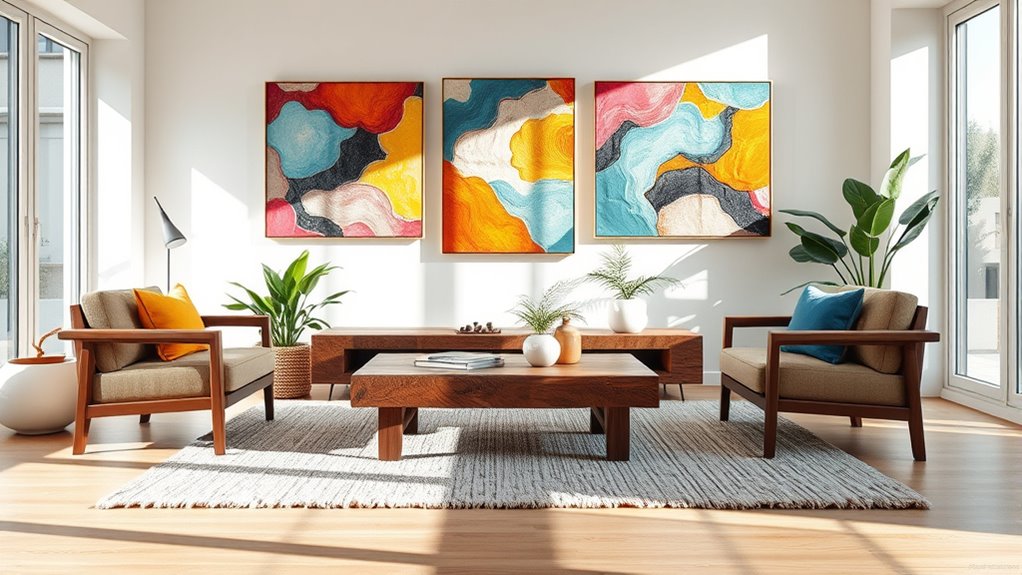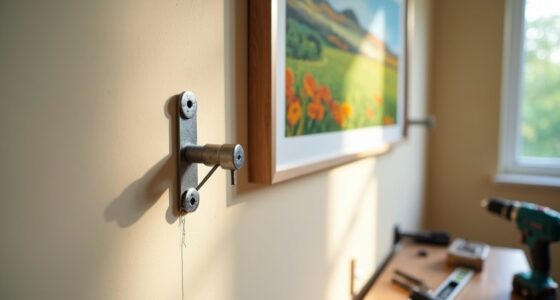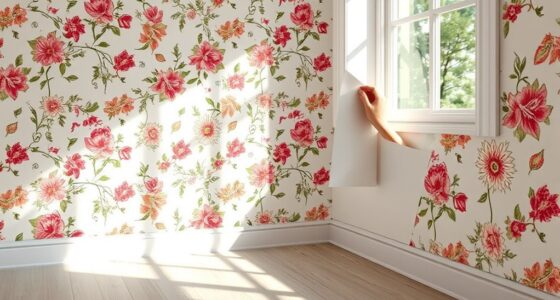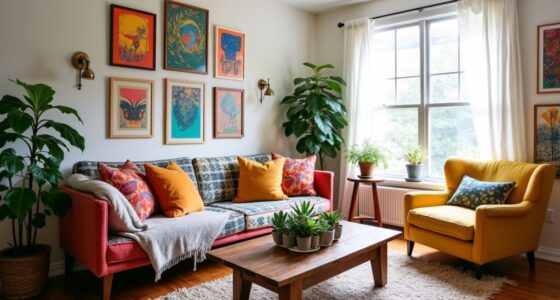To choose wall art that complements your decor style, start by identifying your home’s theme, like bohemian or modern. Consider the color palette; vibrant art can energize neutral spaces. Mix different styles and textures for visual interest, and vary frame sizes for depth. Position larger pieces as focal points and maintain balance with surrounding furniture. Don’t forget to incorporate personal touches that resonate with you. You’ll discover additional tips to enhance your art selection as you explore further.
Key Takeaways
- Identify your decor style to select art that aligns with its unique characteristics, such as colors and themes.
- Consider color harmony; choose artwork that complements or contrasts with your existing color palette for visual appeal.
- Mix different art styles and textures to create depth, ensuring thematic connections unify the collection.
- Pay attention to frame sizes and styles, varying them to enhance visual interest while maintaining a cohesive look.
- Select large pieces as focal points above key furniture, ensuring placement captures attention and evokes emotion.
Understanding Your Home Decor Style

How well do you know your home decor style? Identifying your interior design style—be it bohemian, farmhouse, coastal, modern, or Scandinavian—plays a significant role in selecting art that enhances your space.
Each style has unique characteristics; for example, bohemian embraces vibrant colors, while farmhouse leans towards rustic charm. Understanding these themes helps you choose art that complements your decor, like serene landscapes for coastal designs or bold abstracts for modern aesthetics. Additionally, incorporating elements like exposed beams can enhance the character of your farmhouse style and influence your art choices. The use of natural materials in your decor can further guide your selection of artwork, ensuring it aligns with the overall aesthetic. Furthermore, incorporating innovative design ideas into your space can create a harmonious environment that showcases your chosen art pieces beautifully. To maintain the integrity of your decor, consider using durable materials that can withstand changes over time, ensuring that your art remains a cherished part of your home. Additionally, attention to detail in your decor will help you select art that elevates the overall visual appeal of your space.
Remember, art should enhance your decor without perfectly matching it. Mixing different art styles can add depth while keeping a cohesive look through shared colors or themes.
Trust your instincts and explore various sources to curate a collection that reflects your personality and fits your home decor style.
The Role of Color in Artwork Selection

Choosing the right colors for your artwork can considerably impact the overall aesthetic of your space.
Selecting the perfect colors for your artwork significantly enhances your space’s aesthetic appeal.
When selecting wall art, think about colors that complement or contrast with your decor for visual harmony or striking focal points. Vibrant art prints can breathe life into neutral walls, while neutral backdrops allow the artwork to shine. Additionally, consider incorporating unique dinnerware designs that can elevate the dining experience, creating a cohesive look throughout your home. Proper storage in cool, dark places for your candles can help maintain their integrity and enhance the visual appeal of your decor. To enhance your selection process, remember that smart bathroom technologies often utilize color palettes that promote relaxation and aesthetic appeal. Furthermore, adding bohemian style elements can introduce unique textures and warmth to your walls.
- Energize your room with bold hues.
- Create a serene atmosphere using soft tones.
- Use the color wheel for a visually pleasing effect.
- Make art the focal point with textured pieces.
- Test wall colors alongside art for the best fit.
Additionally, consider how lighting design can enhance the visual appeal of the artwork within your space.
Mixing Different Art Styles
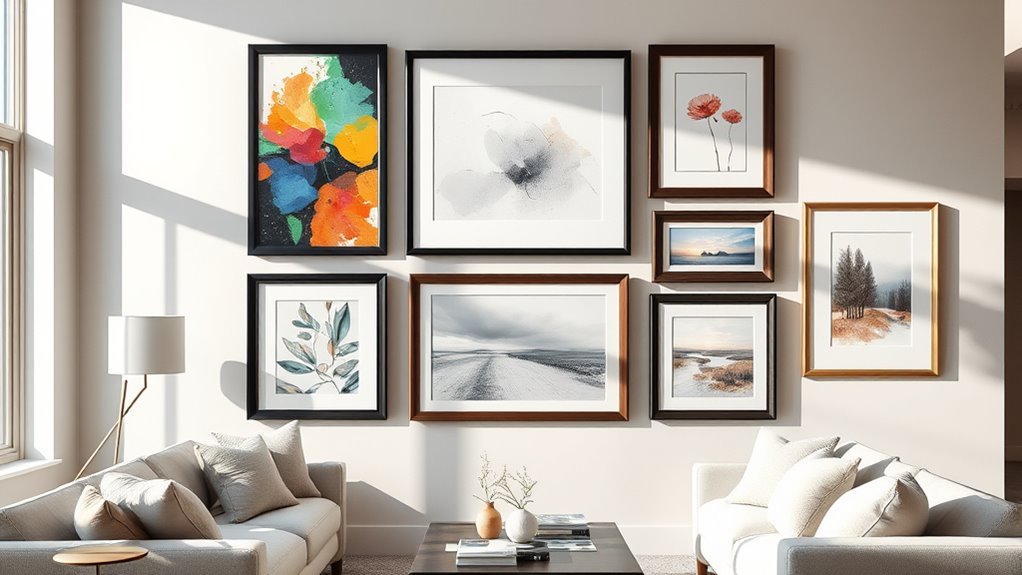
Mixing different art styles can transform your space into a dynamic showcase of creativity.
By layering textures and materials, you create depth, while thematic connections help unify your collection. To enhance the rustic charm of your decor, consider incorporating vintage decor that resonates with your chosen art pieces. Additionally, incorporating eco-friendly toilets as a unique art form can add a touch of whimsy and highlight the intersection of functionality and artistic creativity. Incorporating natural materials such as wood and stone into your art pieces can further enhance the farmhouse aesthetic. You might also explore using essential oils in your creative space to promote a calming atmosphere that complements your art.
Don’t forget to utilize negative space effectively; it can enhance the overall impact of your art arrangement. Incorporating butter sculptures as a unique art form can add a touch of whimsy and highlight the intersection of culinary and artistic creativity.
Layering Textures and Materials
While you might think of wall art as simply paintings or prints, layering textures and materials can transform your decor into a mesmerizing visual experience.
By mixing different elements, like combining paintings with textiles or incorporating three-dimensional sculptures, you add depth and visual interest to your space. Consider these elements to enhance your decor:
- Soft textiles that contrast with hard surfaces
- Vibrant abstract pieces paired with serene botanical illustrations
- Shadow boxes that invite viewers to engage
- Use of negative space to avoid overcrowding
- Regularly rotating art styles for a fresh feel
Incorporating a mindful approach to your decor can enhance your emotional well-being by creating a calm environment that fosters relaxation and clarity. Additionally, using art that reflects your personal journey can create a sense of overall wellness in your living space. Including best lifestyle products can also help to elevate your home aesthetics and functionality. The combination of colors and textures in your artwork can significantly impact your daily living experience.
Furthermore, considering routine health checks for your space, similar to those recommended for pet care, can help maintain a refreshed and inviting atmosphere.
These techniques not only enrich your visual narrative but also create a dynamic environment that reflects your unique style.
Thematic Connections for Unity
Incorporating thematic connections into your wall art can create a sense of unity that ties together various styles and pieces. To achieve this, consider using a consistent color palette that resonates throughout your collection. This harmony allows different art styles to complement each other instead of clashing.
Focus on shared motifs like nature or cultural elements, which enhance the overall aesthetic and provide a cohesive visual language. Additionally, pay attention to the scale and placement of each piece; this guarantees they contribute to a balanced visual narrative. Proper installation methods for displaying art, similar to those used for heat pumps, can ensure safety and enhance the overall presentation. Engaging in creative practice consistently can also lead to a more refined eye for selecting and arranging art that resonates with your decor style.
Layering textures and materials can add depth while maintaining thematic connections that enhance your decor style, resulting in a fascinating and engaging display of art. Moreover, understanding the importance of community collaboration in art projects can inspire more meaningful connections between your chosen pieces and the environment they inhabit.
Utilizing Negative Space Effectively
Utilizing negative space effectively transforms your wall art display into a balanced visual experience that highlights each piece’s unique character.
By strategically leaving areas of blank wall, you create a harmonious flow that prevents overcrowding. Mixing different art styles becomes effortless when you allow negative space to serve as a unifying element, ensuring each artwork stands out.
- Draw attention to your favorite pieces
- Create a soothing atmosphere
- Enhance the overall aesthetic
- Encourage creativity in arrangement
- Foster a sense of balance
Importance of Frame Sizes and Styles

Choosing the right frame sizes and styles is essential for creating a visually engaging art display. Varying frame sizes adds depth and visual interest, keeping your wall from appearing monotonous. By incorporating both smaller and larger frames, you encourage a dynamic arrangement that fosters a relaxed and inviting atmosphere.
Different frame styles can also create a cohesive look, especially when they share similar colors or materials, linking various art pieces and your decor style together. Don’t forget to take into account the scale of your frames in relation to the wall space—larger frames can act as statement pieces that draw attention.
Mixing sizes and styles not only enriches the visual appeal but also invites conversation, creating a gallery-like atmosphere in your home.
Strategic Placement of Art Pieces
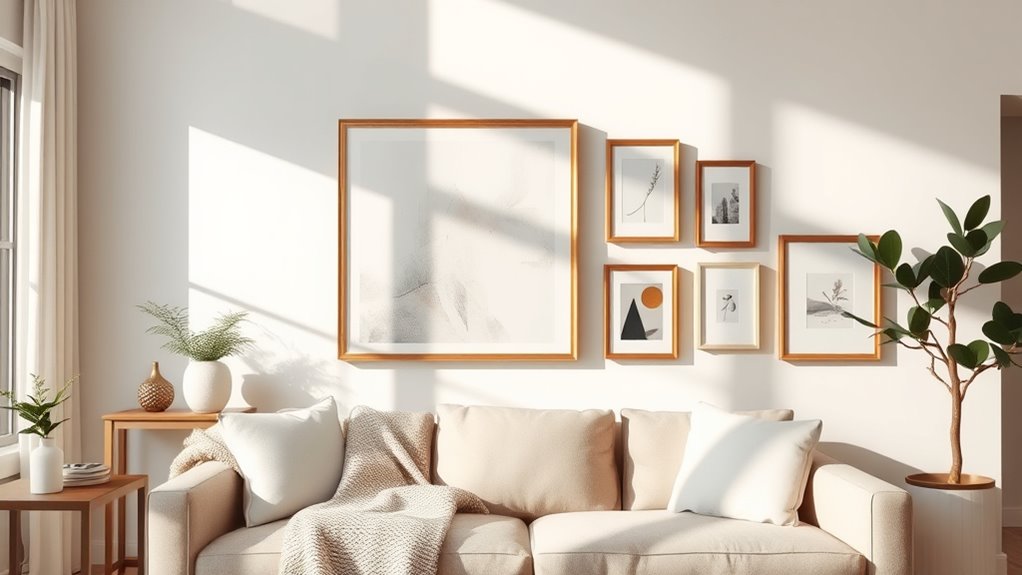
When you hang your art pieces, aim for eye level to create a striking focal point that everyone can enjoy.
It’s also important to balance your artwork with nearby furniture, ensuring there’s enough space to enhance visual appeal without causing distractions.
Eye-Level Hanging Techniques
Hanging artwork at eye level—typically between 57 to 60 inches from the floor—ensures it’s easily appreciated and comfortable for most viewers.
When placing your pieces, keep these tips in mind:
- Create a welcoming atmosphere
- Enhance your home’s personality
- Foster meaningful conversations
- Evoke nostalgia and memories
- Inspire creativity and imagination
If you’re hanging multiple pieces, make sure the center aligns with eye level.
In dining areas, lower the artwork to around 48 inches for intimacy. Always leave 2 to 4 inches between the bottom of the art and adjacent furniture to avoid overcrowding.
Balancing Artwork With Furniture
Artwork and furniture should complement each other to create a cohesive and inviting space.
When balancing artwork with furniture, hang your art at eye level to guarantee maximum appreciation. Make sure it aligns with the height of surrounding pieces for a harmonious look. Leave a gap of 6 to 12 inches between the art and furniture to create visual breathing space, preventing distractions.
Consider the scale of your artwork; larger pieces can serve as focal points above sofas or dining tables. Utilize walls flanking furniture like couches or beds for strategic placement.
Finally, choose artwork that reflects the colors or materials of your furniture, guaranteeing a unified aesthetic and enhancing the overall design of the room.
Creating a Focal Point With Art

How can you transform a room with just a single piece of art? A large, bold artwork can serve as a stunning focal point, drawing attention and setting the tone for your decor style.
Position it above key furniture like sofas or dining tables to maximize its impact. Consider contrasting colors to help it pop against the wall.
Alternatively, create a dynamic focal point with a gallery wall of smaller pieces for personal expression.
- It captures attention.
- It evokes strong emotions.
- It defines your style.
- It boosts room intimacy.
- It enhances visual interest.
Maintaining Balance and Harmony
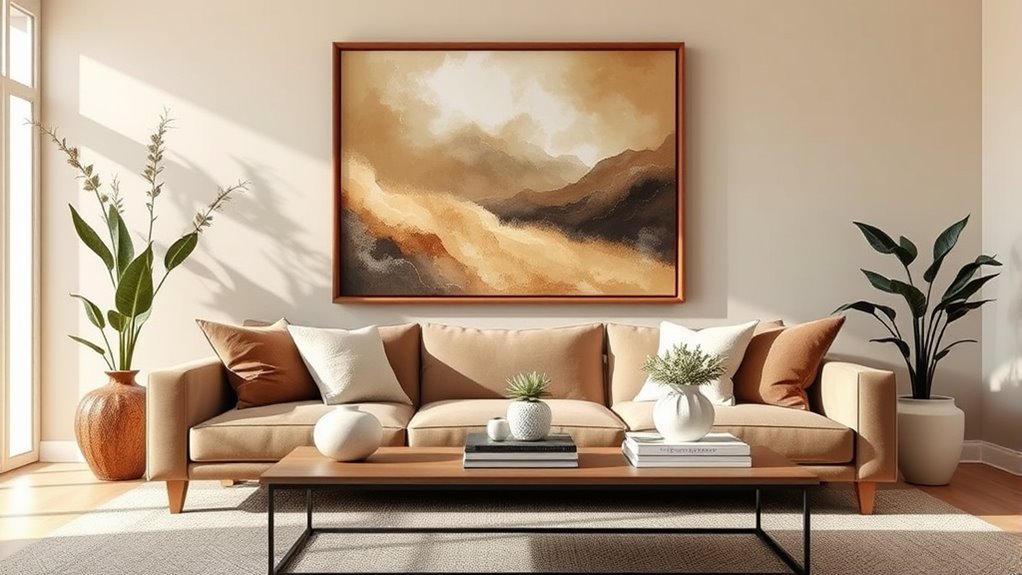
While selecting wall art, it’s important to maintain balance and harmony within your space. Art is key to achieving this.
Choose pieces that harmonize with your room’s color palette, ensuring they complement rather than clash with existing decor. Mixing different art styles can add visual interest, but maintain a unifying thread—like a similar color scheme or theme—to preserve overall harmony.
Select wall art that aligns with your color palette, blending styles while keeping a cohesive theme for visual harmony.
Pay attention to scale; large pieces can act as focal points, while smaller works should be grouped to create a cohesive display.
Utilize negative space effectively around your art to enhance its impact and prevent overcrowding.
Regularly updating your art displays can refresh your room’s aesthetic, helping you keep maintaining balance with your evolving decor and personal style.
Incorporating Personal Touches in Art

Incorporating personal touches in your wall art not only enhances your decor but also reflects your unique personality and experiences.
When choosing art, consider pieces that resonate with your passions or memories, creating an emotional connection to your space.
Here are some ways to add those personal touches:
- Select art that showcases your favorite travel destinations.
- Include family heirlooms or handmade pieces for a unique narrative.
- Choose colors and themes that align with your existing decor.
- Mix different art styles to express diverse aspects of your personality.
- Rotate your art collection to include new experiences and memories.
Regularly Updating Your Art Collection

Your art collection should evolve just like your personal experiences and tastes. Regularly updating your art keeps your home decor vibrant and in tune with your current interior style.
Consider rotating your artwork seasonally; this introduces new colors and themes that reflect changing moods and trends. Adding new pieces enhances the depth and diversity of your collection, creating a dynamic visual experience throughout your home.
Don’t hesitate to replace artworks that no longer resonate with you, ensuring your collection truly represents your identity.
Engaging with local artists or visiting art events can provide unique opportunities to discover works that complement your existing decor. By revitalizing your art, you invite inspiration and individuality into your living space.
Frequently Asked Questions
What Is the 2/3 Rule for Wall Art?
The 2/3 rule for wall art suggests that your artwork should occupy about two-thirds of the available wall space for a balanced look.
When you hang art, aim for the center to be around 57 to 60 inches from the floor, making it easy to view. This guideline guarantees the art complements your decor without overwhelming it.
You can also apply this rule to groupings, creating a cohesive and aesthetically pleasing display.
How Do You Choose Wall Art That Goes Together?
Imagine a garden where each flower blooms in harmony, creating a vibrant tapestry.
To choose wall art that goes together, start by evaluating your room’s mood and color palette. Mix styles, like paintings and photographs, but keep a unifying theme.
Experiment with placements, letting your instincts guide you, while ensuring balance. Embrace pieces that resonate with you emotionally; they’ll enrich your space, just like a well-tended garden nurtures the soul.
What Is the Rule of Wall Decor?
The rule of wall decor is simple: art should enhance your space without overwhelming it.
You want to choose pieces that complement your existing decor, focusing on scale and placement. Larger works can be stunning focal points, while smaller pieces fill in gaps.
Mixing styles is great, but keep a unifying theme, like color or subject.
Hang art at eye level with adequate spacing for maximum visual impact, ensuring everything feels cohesive and inviting.
Does Artwork Have to Match Decor?
No, artwork doesn’t have to match your decor.
In fact, it can enhance your space by adding depth and contrast. Mixing different art styles creates visual interest, as long as you maintain a unifying element like color or theme.
Feel free to incorporate various colors and textures; they’ll enrich your aesthetic.
Trust your instincts and choose pieces that resonate with you, making your decor more expressive and uniquely yours.
Conclusion
In the world of decor, your wall art is like the cherry on top of a sundae—it’s what pulls everything together. By understanding your style, considering colors, and mixing art forms, you can create a harmonious space that reflects your personality. Remember, just as Picasso evolved over time, so can your collection. Don’t hesitate to update your art; it keeps your home fresh and vibrant, ensuring your walls tell a story that’s uniquely yours.
